

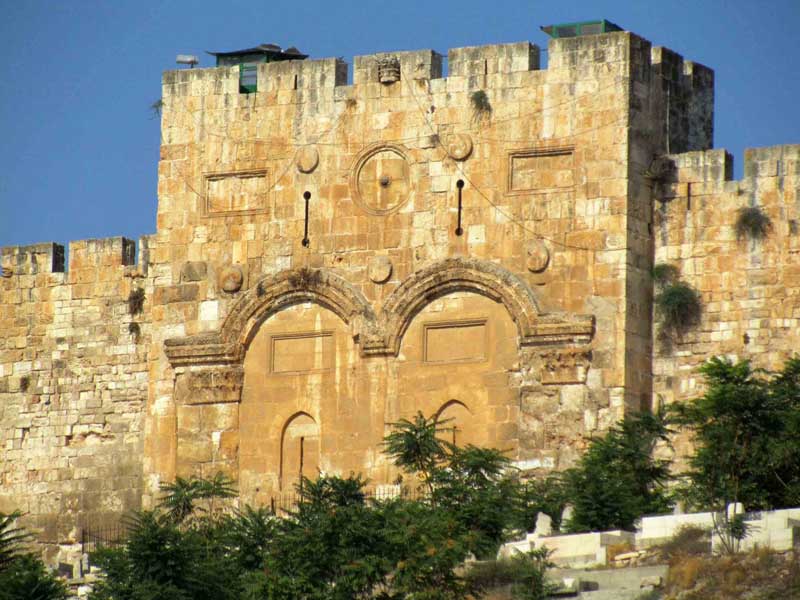
The Golden Gate, as it is called in Christian literature, is the oldest of the current gates in Jerusalem's Old City Walls. According to Jewish tradition, the Shekhinah (Divine Presence) used to appear through this gate, and will appear again when the Messiah comes (Ezekiel 44:1-3) and a new gate replaces the present one; that is why Jews used to pray for mercy at the former gate at this location.Hence the name Sha'ar Harachamim the Gate of Mercy.
In Christian apocryphal texts, the gate was the scene of a meeting between the parents of Mary, so that Joachim and Anne Meeting at the Golden Gate became a standard subject in cycles depicting the Life of the Virgin. It is also said that Jesus passed through this gate on Palm Sunday. In Arabic, it is known as the Gate of Eternal Life. In ancient times, the gate was known as the Beautiful Gate.
Remains of a much older gate dating to the times of the Second Jewish Temple were found. The present one was probably built in the 520s AD, as part of Justinian I's building program in Jerusalem, on top of the ruins of the earlier gate in the wall. An alternate theory holds that it was built in the later part of the 7th century by Byzantine artisans employed by the Umayyad khalifs.
The gate is located in the middle of the eastern side of the Temple Mount. The portal in this position was believed to have been used for ritual purposes in biblical times.
The Ottoman Sultan Suleiman the Magnificent sealed off the Golden Gate in 1541. While this may have been purely for defensive reasons, in Jewish tradition, this is the gate through which the Messiah will enter Jerusalem and it is suggested that Suleiman the Magnificent sealed off the Golden Gate to prevent the Messiah's entrance.
The Muslims also built a cemetery in front of the gate, in the belief that the precursor to the Messiah, Elijah, would not be able to pass through the Golden Gate and thus the Messiah would not come. This belief was based upon two premises. First, according to Islamic teaching Elijah is a descendant of Aaron, making him a priest or kohen. Secondly, that Jewish priests are not permitted to enter a cemetery. This second premise is not wholly correct because a kohen is permitted to enter a cemetery in which primarily non-Jews are buried such as the one outside the Golden Gate.
The Golden Gate is one of the few sealed gates in Jerusalem's Old City Walls, along with the Huldah Gates, and a small Biblical and Crusader-era postern located several stories above ground on the southern side of the eastern wall. Gate of Mercy, the Gate of Gold, the Gate of Eternal Life, Sha'ar Harahamim - appears in the legends of all three religions. An early Jewish tradition holds that it is through that gate that the Messiah will enter Jerusalem. According to Christian tradition, Jesus made made his last entry to Jerusalem through the Mercy Gate. The Muslims refer to it as the Gate of Mercy and believe it to be the gate referred to in the Koran, through which the just will pass on the Day of Judgment.
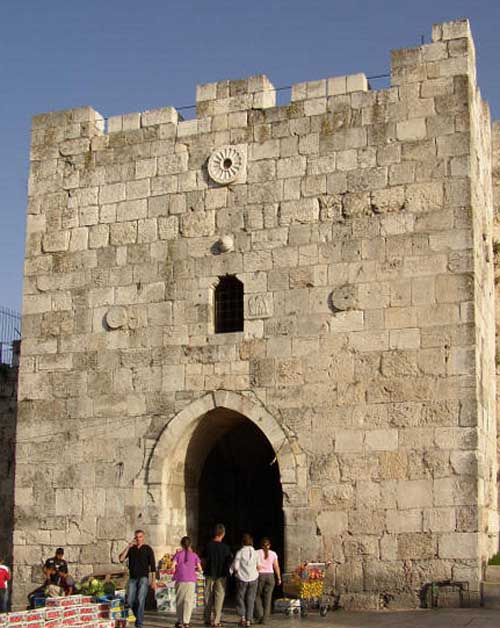
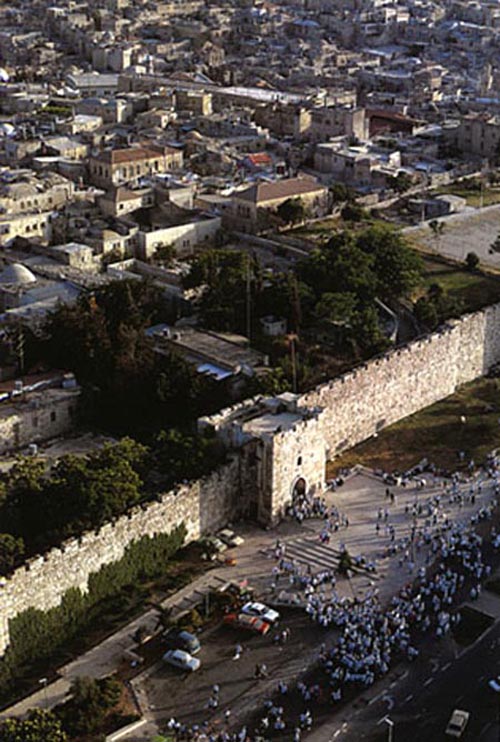
The first name was given to the gate by pilgrims, who erroneously believed that it led to Herod's palace. It is known in Arabic as the Flower Gate. It is a gate in the walls of the Old City of Jerusalem. Its elevation is 755 meters above sea level. It adjoins the Muslim Quarter, and is a short distance to the east of the Damascus Gate. In proximity to the gate is an Arab neighborhood called Bab a-Zahara, a variation of the Arabic name for the gate.
This modest gate is one of the newest gates of Jerusalem. At the time when Suleiman the Magnificent built the wall, a small wicket gate was situated in front of the current gate, which was rarely opened. By 1875, in order to provide a passageway to the neighborhoods which were beginning to develop north of the Old City, the Ottomans made a breach in the northern part of the structure and closed the original opening.
The gate is named after Herod the Great. That is because in the Crusaders' period a church was built near the gate in the belief that at the time of the Crucifixion of Jesus, Herod Antipas's house was situated at that spot. In its place today stands the church of Dir Al Ads.
In 1998 and during several subsequent excavation seasons (the latest in 2004), archaeologists of the Israel Antiquities Authority dug in the eastern area of Herod's Gate. The digging focused on three separate areas adjacent to the wall, in which nine archeological layers were discovered - covering from the Iron age up through the Turkish period.
Among the most significant discoveries were structures from the period of the Second Temple, a complete segment of the Byzantine-Roman wall, and remnants of massive construction underneath the wall. These remnants were identified as portions of a fortification from the ancient Muslim period and from the Middle Ages. These discoveries point out the importance which the rulers of the city gave to the fortification of one of its most sensitive places - the northern wall of Jerusalem - as historical accounts indicate that circa 1099 the Crusader soldiers in the command of Godfrey of Bouillon entered the city through a breach located in proximity to the present Herod's Gate.

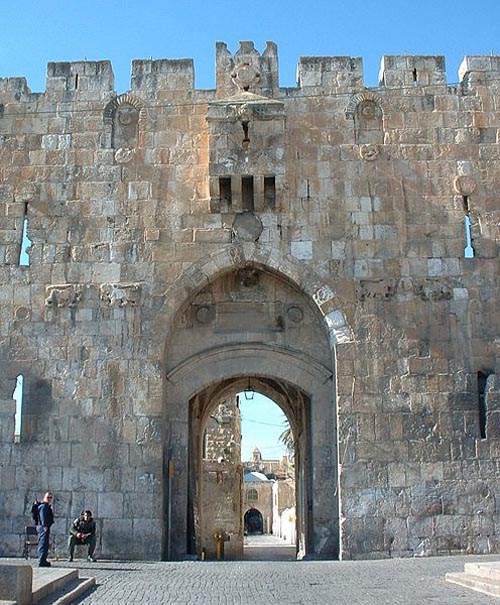
The Lions' Gate, Stephen's Gate, or Sheep Gate, is located in the Old City Walls of Jerusalem and is one of seven open Gates in Jerusalem's Old City Walls.
Located in the east wall, the entrance marks the beginning of the traditional Christian observance of the last walk of Jesus from prison to crucifixion, the Via Dolorosa. Near the gate's crest are four figures of panthers, often mistaken for lions, two on the left and two on the right. They were placed there by Sultan Suleiman the Magnificent to celebrate the Ottoman defeat of the Mamluks in 1517.
Legend has it that Suleiman's predecessor Selim I was captured by lions that were going to eat him because of his plans to level the city. He was spared only after promising to protect the city by building a wall around it. This led to the lion becoming the heraldic symbol of Jerusalem. However, Jerusalem already had been, from Biblical times, the capital of the Kingdom of Judah, whose emblem was a lion (Genesis 49:9).
In another version, Suleiman taxed Jerusalem's residents with heavy taxes which they could not afford to pay. That night Suleiman had a dream of two lions coming to devour him. When he woke up, he asked his dream solvers what his dream meant. A wise respected man came forward and asked Suleiman what was on his mind before drifting to sleep. Suleiman responded that he was thinking about how to punish all the men who didn't pay his taxes. The wise man responded that since Suleiman thought badly about the holy city, God was angry. To atone, Suleiman built the Lions' Gate to protect Jerusalem from invaders.
Israeli paratroops from the 55th Paratroop Brigade came through this gate during the Six-Day War of 1967 and unfurled the Israeli flag above the Temple Mount.
The Lions' Gate is not to be confused with the Zion Gate in the Old City Wall, located in the south, leading to the Jewish and Armenian Quarters.
The magnificent walls of Jerusalem's Old City were built by the Ottoman Empire under the direct supervision of Sultan Suleiman in 1542. The walls stretch for approximately 4.5 kilometers (2.8 mi) and rise to a height of 5-15 meters (16-49 feet), with a thickness of 3 meters (10 feet). Altogether, the Old City walls contain 43 surveillance towers and 11 gates, seven of which are presently open.
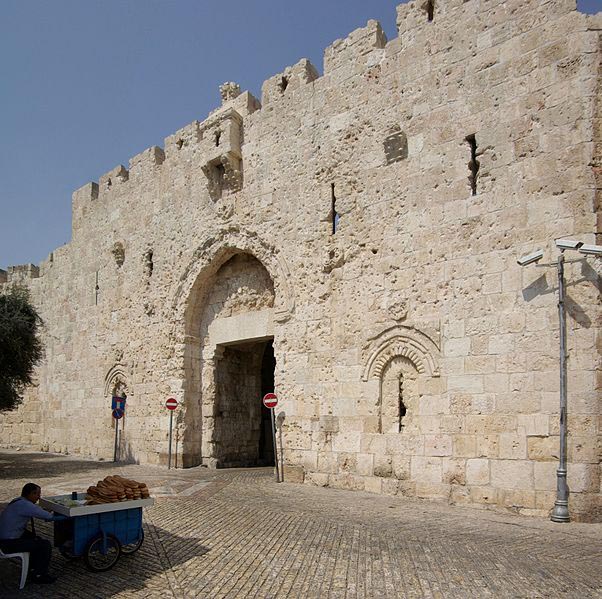
The Zion Gate, also known in Arabic as Bab Harat al-Yahud ("Jewish Quarter Gate"), or Bab an-Nabi Dawud ("Prophet David Gate"), is one of eight gates in the walls of the Old City of Jerusalem.
Located in the south of the Old City, facing Mount Zion and Hebron, the Zion Gate leads into the Armenian and Jewish Quarters. Zion Gate is also known as David's Gate because the tomb of King David is believed to be on Mt. Zion. The gate was built for Suleiman the Magnificent in 1540. In the 19th century, an area close to the gate was the gathering place of lepers.
In the 1948 Arab-Israeli War, the Palmach gained control of the Jewish Quarter via the Zion Gate. The stones surrounding the gate were pockmarked by weapons fire and bullet holes that are still visible today. The last British troops leaving Jerusalem on May 13, 1948, presented Mordechai Weingarten with the key to the gate. The gate was under the rule of Jordan until the Six-Day War.
Both pedestrians and vehicles use the gate, although maneuvering is difficult due to the L-shaped passageway. Until recently, there was two-way vehicular traffic passing through the gate. Today cars can exit but not enter the Old City via this gate.
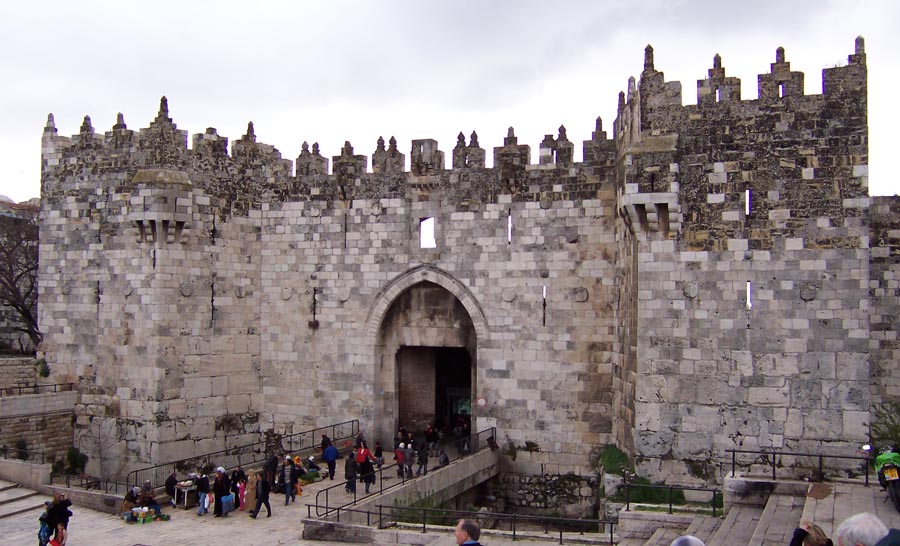
Damascus Gate is the main entrance to the Old City of Jerusalem. It is located in the wall on the city's northwest side where the highway leads out to Nablus, and from there, in times past, to the capital of Syria, Damascus; as such, its modern English name is Damascus Gate, and its modern Hebrew name, Sha'ar Shkhem meaning Shechem Gate, or Nablus Gate. Of its Arabic names, Bab al-Nasr means "gate of victory," and Bab al-Amud means "gate of the column." The latter name, in use continuously since at least as early as the 10th century, preserves the memory of a design detail dating to the 2nd century AD Roman era gate.
In its current form, the gate was built in 1537 under the rule of Suleiman the Magnificent, the Sultan of the Ottoman Empire. Underneath, remains of a gate dating to the time of the Roman rule of Hadrian in the 2nd century AD have been discovered and excavated.
In front of this gate stood a Roman victory column topped with the Emperor Hadrian's image, as depicted on the 6th century Madaba Map. This historical detail is preserved in gate's Arabic name, Bab el-Amud, meaning "gate of the column".
On the lintel to the 2nd century gate, under which one can pass today, is inscribed the city's name under Roman rule, Aelia Capitolina. Hadrian had significantly expanded the gate which served as the main entrance to the city from at least as early as the 1st century BC during the rule of Agrippa.
One of eight gates remade in the 10th century, Damascus Gate is the only one to have preserved the same name (i.e. Bab al-Amud) in modern times. The Crusaders called it St. Stephen's Gate (in Latin, Porta Sancti Stephani), highlighting its proximity to St. Stephen's Church and the site of his martyrdom. Several phases of construction work on the gate took place the early Ayyubid period (1183-1192) and both early 12th century and later 13th century Crusader rule over Jerusalem. A 1523 account of a visit to Jerusalem by a Jewish traveller from Leghorn uses the name Bab el 'Amud and notes its proximity to the Cave of Zedekiah.
Damascus Gate is flanked by two towers, each equipped with machicolations. It is located at the edge of the Arab bazaar and marketplace. In contrast to the Jaffa Gate, where stairs rise towards the gate, in the Damascus Gate, the stairs descend towards the gate. Until 1967, a crenellated turret loomed over the gate, but it was damaged in the fighting that took place in and around the Old City during the Six-Day War.
In August 2011, Israel restored the turret, including its arrowslit, with the help of pictures from the early twentieth century when the British Empire controlled Jerusalem. Eleven anchors fasten the restored turret to the wall, and four stone slabs combine to form the crenellated top.
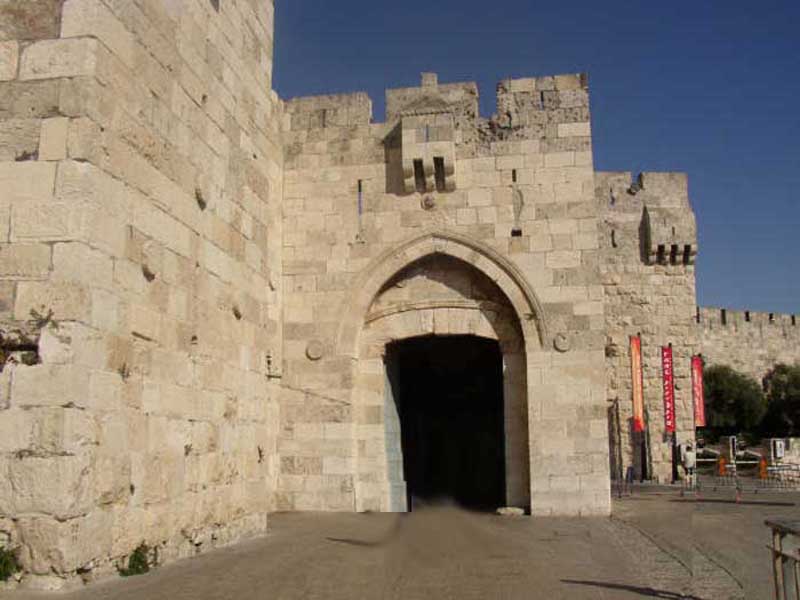

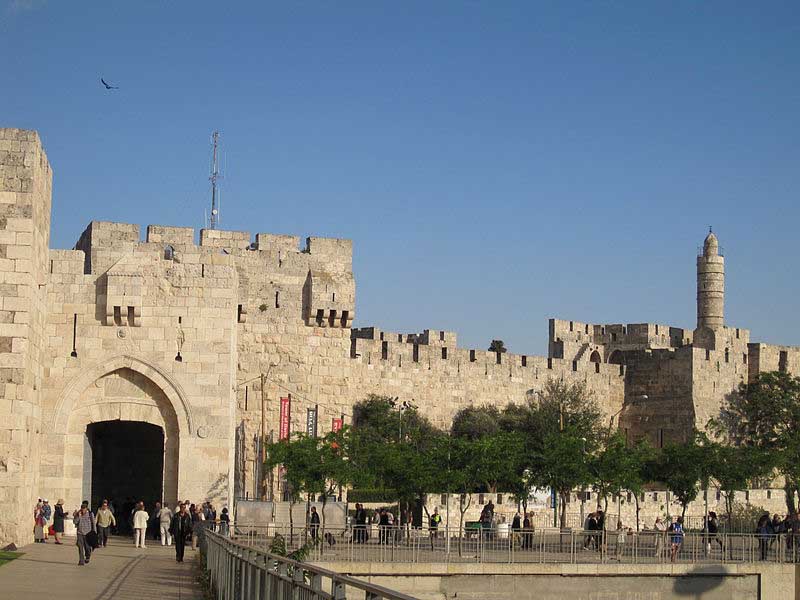
Jaffa Gate, also Arabic, Bab Mihrab Daud, "Gate of the Prayer Niche of David"; also David's Gate) is a stone portal in the historic walls of the Old City of Jerusalem. It is one of eight gates in Jerusalem's Old City walls.
Jaffa Gate was inaugurated in 1538 as part of the rebuilding of the Old City walls by Suleiman the Magnificent.
In 1917, British general Edmund Allenby entered the Old City through the Jaffa Gate, giving a speech at the nearby Tower of David. Allenby entered the city on foot in a show of respect for the city and a desire to avoid comparison with the Kaiser's entry in 1898. The British demolished other buildings adjoining the city wall in 1944 in an attempt to preserve Jerusalem's historic vistas.
During the 1948 Arab–Israeli War, Israeli forces fought hard to connect the Jewish Quarter of the Old City with Israeli-held western Jerusalem by controlling the Jaffa Gate. On the evening of May 18, 1948, the Haganah launched a frontal assault on the gate but were beaten back with heavy losses. With a Jordanian victory in 1948, Israeli forces were not able to gain control of the gate until the Six Day War in 1967.
In 2000 Pope John Paul II came through Jaffa Gate to the Old City during his visit in Israel in the Holy Year.
The street leading east from the Jaffa Gate was once called "Capital Street" but today is known as "David Street" and is one of the principal streets for souvenir shopping.
Just inside the gate, behind an iron grating on the left, lie two tombs. These are believed to be the graves of the two architects whom Suleiman commissioned to construct the Old City walls. According to legend, when Suleiman saw that the architects had left Mount Zion and the tomb of King David out of the enclosure, he ordered them killed. However, in deference to their impressive achievement, he had them buried inside the walls next to Jaffa Gate.
Jaffa Gate is the only one of the Old City gates positioned at a right angle to the wall. This could have been done as a defensive measure to slow down oncoming attackers, or to orient it in the direction of Jaffa Road, from which pilgrims arrived at the end of their journey from the port of Jaffa.
Both the Jaffa Gate and Jaffa Road are named after the port of Jaffa, from which the Prophet Jonah embarked on his sea journey and pilgrims debarked on their trip to the Holy City. The modern-day Highway 1, which starts from the western end of Jaffa Road, completes the same route to Tel Aviv-Jaffa.
The Arabic name for the gate, Bab el-Khalil (Gate of the Friend), refers to Abraham, the beloved of God who is buried in Hebron. Since Abraham lived in Hebron, another name for the Jaffa Gate is "Hebron Gate". The Arabs also called this gate Bab Mihrab Daud (Gate of the Prayer Niche of David), since King David is considered a prophet by Islam. The Crusaders, who rebuilt the citadel to the south of Jaffa Gate, also built a gate behind the present location of Jaffa Gate, calling it "David's Gate".
Like the stones used for the rest of the Old City walls, the stones of Jaffa Gate are large, hewn, sand-colored blocks. The entryway stands about 20 feet (6 meters) high, and the wall rises another 20 feet above that.
The modern gateway is, in fact, a breach in the wall made in 1898 when German Emperor Wilhelm II insisted on entering the city mounted on his white horse. Local legend said that Jerusalem would be ruled by a king who entered the city's gates on a white horse, so to satisfy the emperor's vanity and avoid the fate foretold by legend, a breach was made in the wall rather than allow him to ride through a gate.
The Tower of David is an ancient citadel located near the Jaffa Gate entrance to the Old City of Jerusalem. Built to strengthen a strategically weak point in the Old City's defenses, the citadel that stands today was constructed during the 2nd century BCE and subsequently destroyed and rebuilt by, in succession, the Christian, Muslim, Mamluk, and Ottoman conquerors of Jerusalem. It contains important archaeological finds dating back 2,700 years, and is a popular venue for benefit events, craft shows, concerts, and sound-and-light performances.
After the recapture of Jerusalem in 132 AD the emperor Hadrian had the city rebuilt as a Roman city called Aelia Capitolina and a tall pillar in the plaza inside the Damascus Gate was the starting point for measurements to other cities, as indicated in the mosaic Madaba Map. This pillar appears to have fallen or been demolished during the Byzantine period.
In the 20th Century the plaza outside the Jaffa Gate served the same purpose. During the British Mandate for Palestine a marker outside the doorway served as the zero point for distances to and from Jerusalem. There is no such marker today.

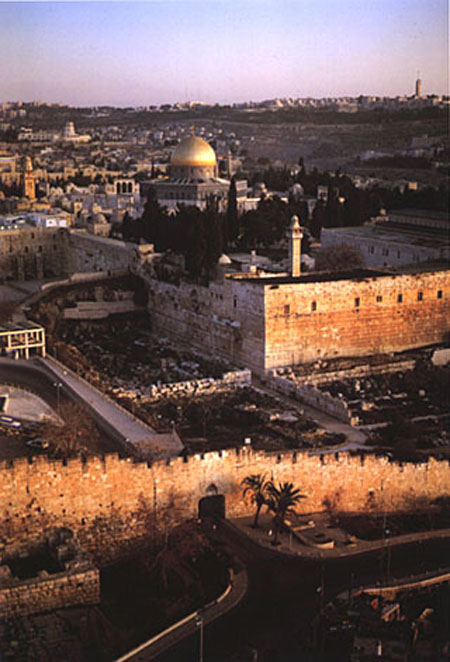
The Dung Gate, also known as Sha'ar Ha'ashpot, Gate of Silwan, Mograbi Gate, is one of the gates in the walls of the Old City of Jerusalem. The gate is situated near the southeast corner of the old city, southwest of the Temple Mount. The gate is the closest to the Western Wall and is a main passage for vehicles. It was originally much smaller, but was enlarged in 1952, after the Old City came under Jordanian control in 1948. After its capture by Israel in 1967, architect Shlomo Aronson was commissioned to renovate this gate. Directly behind the gate lies the entrance to the Western Wall compound.
The name Sha'ar Ha'ashpot appears in the Book of Nehemiah:3:13-14. It is probably named after the residue that was taken from the Jewish Temple into the Valley of Hinnom, where it was burned. This ancient "Dung Gate" may not have been in the same location as the modern gate. The name Mograbi gate (Bab al-Magharibeh) refers to the Moroccan Quarter or (Mughrabi quarter) now destructed, which was situated near the area.
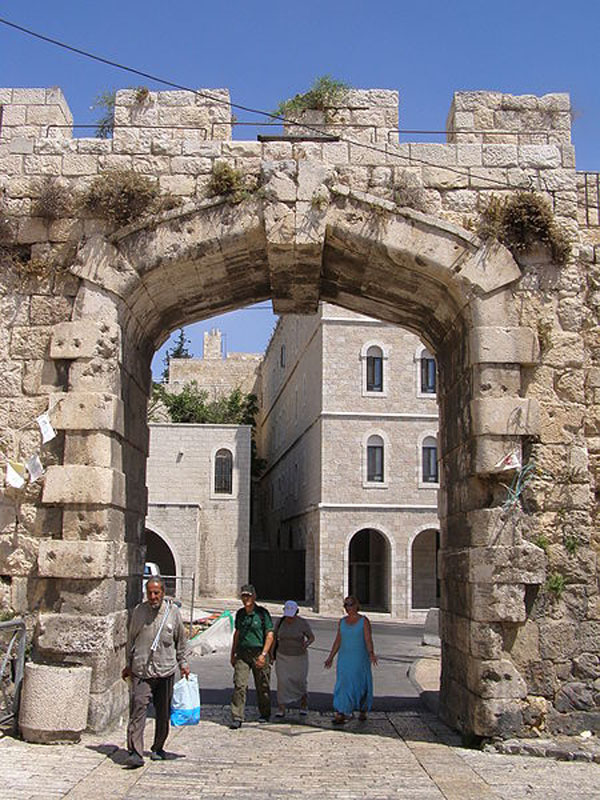
The New Gate is the newest gate in the walls that surround the Old City of Jerusalem. It was built in 1889 to provide direct access between the Christian Quarter and the new neighborhoods then going up outside the walls.The arched gate is decorated with crenelated stonework. The New Gate was built at the highest point of the present wall, at 790 meters above sea level.
During the 3rd and 4th centuries the northern wall was rebuilt and improved by the Byzantines leaving no trace or record of a gate in this sector of the fortification. While there is no information about a gate preexisting at this point in the wall before the city was occupied by the Crusaders, there is a suggestion that they maintained a small postern gate, named after St. Lazarus, just east of the Ottoman construction for the use of troops stationed at Tancred's Tower (Goliath's Tower).
Uncovered during drainage and sewage works in the area, it may have also been used by the knights of the Leper's Order also quartered there. Early records of the Crusades suggest the wall was breached after the Crusader occupation on the orders of Tancred The gate may well have been, with the tower subsequently named after him. The breach may have been later converted into a gate.
The Crusader gate may have been sealed up following Saladin's capture of Jerusalem in 1187 because it did not conform to architectural style of fortifications used by the Turkish armies. The earlier Crusader gate had " ... a roundabout entrance, dim approaches, and a tower that protruded from the line of fortifications." By contrast the earlier gates as well as the Ottoman gate are constructed within the city, and aligned with the facade of the of the wall. The older gates were probably sealed by the external wall built in 1516 by Suleiman the Magnificent. However, another gate was reported in the 16th century called the Gate of the Serbian Monastery, that was used by the Franciscans while they were building the Church of St. Salvatore.
It was built at the request of the French Consul to provide access to the Old City from the Notre Dame Hospice that was completed in 1886, and to provide Russian Christian pilgrims living at the Russian Compound (outside the Old City walls) direct access to the Church of the Holy Sepulchre in the Christian Quarter. Contrary to popular belief, Kaiser Wilhelm II during his visit to Jerusalem entered not through the New Gate, but through the "Hole in the Wall", made so that he wouldn't have to dismount his carriage to enter the city.
From the beginning of the First World War the headquarters of Roshen Bey, the most senior Ottoman military officer in the Jerusalem area, was located at the Notre Dame Hospice opposite the New Gate.
During the 1920s and 1930s the New Gate became the nearest gate to the modern city Jerusalem with the Christian Brothers' College located just inside its structure in the Old City. At this time the New Gate, as all gates to the Old City, included an iron gate which was operated by the police, and shut as required by the administrative regulations.
On the afternoon of Friday, August 23, 1929, an unprovoked attack was staged by the Arabs from the Old City between the New and Damascus gates that resulted in the killing of several Jews after the Arabs were inflamed by the sermons during the noon prayers at Haram esh Sherif.
From 1946 and until Independence the British Administration created a security zone between the New Gate and Jaffa Road, called euphemistically Bevingrad for Ernest Bevin, due to the terrorist activity from both sides. On November 15, 1945 the Stern Gang attempted to demolish part of the wall next to the New Gate, using a massive device that required ten men to transport and emplace; however it failed to function.
During the 1948 Arab-Israeli war, David Shaltiel's Etzioni Brigade (Hagana) failed to capture East Jerusalem from the local Arab defenders reinforced by a company of the Arab Legion's 6th battalion during Operation Kedem.
This occurred not because of Arab offensive action, which was restrained by orders of John Bagot Glubb, but because the Jewish demolition charge intended for the iron gate was detonated by a stray artillery shell that set the Arab wooden barricade in front of the New Gate on fire, halting the Stern Gang, Hagana and Irgun troops' advance just prior to the ceasefire announcement. Subsequently the Jordanian occupation administration had the gate sealed off. It was reopened again by the Israeli Army in 1967 following the capture of East Jerusalem during the Jordanian campaign.
The gate itself is maintained under the preservation orders, supervised by the Israel Antiquities Authority. The land around the New Gate is largely owned by the Latin Patriarchate and the Franciscan Order, which have refused to sell it to the Israeli government. It required many years to lease land from the Patriarchate between the New Gate and the Damascus Gate for a park. In the current urban layout of Jerusalem the New Gate provides the quickest route from the Old City to West Jerusalem, including via Egged No.1 & 2 buses, via its HaSha'ar HaKhadash road.